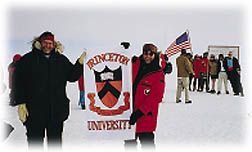First Person - February 23, 2000
There's no place like the South
Pole for New Year's
In December, the sun is always up in Antarctica
by Stephen R. Dujack '76
The New York Times reported in December that there was some controversy
over what spot on Earth would be the first to experience the new millennium.
Kiribati changed its time zone so as to be the easternmost nation on the
International Date Line. Pitt Island off New Zealand claimed that it would
be the first inhabited land to see the first dawn. The U.S. government's
official in charge of time challenged those assertions by proclaiming midnight
at the prime meridian, Greenwich Time, to be the new millennium. But there
is one place where the Date Line and all lines of longitude intersect and
where the sun had been up for weeks: the South Pole.
 So that's where I was on December 31, 1999. It's not an easy place to
get to, unless you are a researcher supported by the U.S. government, which
maintains a base at the Pole. You have to write a very long check to the
one private company that takes tourists to the Antarctic interior, a Canadian
firm named Adventure Network International. Then you spend up to a week
staging a flight from southern Chile to the organization's base camp in
the Ellsworth Mountains, followed by perhaps another week waiting for weather
to clear for a dash to the Pole.
So that's where I was on December 31, 1999. It's not an easy place to
get to, unless you are a researcher supported by the U.S. government, which
maintains a base at the Pole. You have to write a very long check to the
one private company that takes tourists to the Antarctic interior, a Canadian
firm named Adventure Network International. Then you spend up to a week
staging a flight from southern Chile to the organization's base camp in
the Ellsworth Mountains, followed by perhaps another week waiting for weather
to clear for a dash to the Pole.
We reached the base camp easily, but for days the weather kept us from
flying to the Pole. But conditions magically changed at the last minute,
and nine tourists arrived on a Twin Otter ski plane a few hours before midnight
on New Zealand time, the time kept by Amundsen-Scott Base.
As we stepped out onto the ice, scientists were surveying the exact spot
of the Pole. The two-mile-thick ice sheet drifts about 30 feet a year, and
by tradition the marker for the Pole is moved to its true location a few
hours into the new year. Finishing their work, the scientists placed a short
bamboo stick with a red flag on top at the appropriate spot.
So that's where we were with about 10 minutes to go, the nine of us alone,
staring at this ludicrously inadequate marker and wondering if we were the
only people on Earth who thought it important to be at the Pole for this
historic event. Where were the 200-odd members of the base? Partying inside
where it was warm, of course; the outdoor temperature was -22 degrees. (We
were pouring champagne into glasses only to watch it freeze before we could
drink it.) But within minutes about a hundred inebriated scientists and
support personnel surrounded the slender reed. Suddenly we realized that
nobody knew the exact time. This was disastrous! To the rescue came Antony
A. Stark *79, an astrophysicist at the base who had a GPS unit with him,
which receives the exact time from the satellite system.
Stark began a countdown with one minute to go, and about a dozen people
silently placed their hands one above the other atop the stick as the rest
of the crowd pressed around us. The countdown was as intense as a rocket
launch, and the seconds afterward just as loud. People hugged each other
in their puffy down parkas, ran in circles through all the time zones, made
toasts, posed for pictures, performed inane stunts, then silently drifted
inside. Ten minutes into the new millennium, there were only tourists alone
in the cold at the South Pole. We quietly got into our plane and flew back
north.
Stephen Dujack is director of communications at the Environmental Law
Institute in Washington, D.C.
GO TO
the Table of Contents of the current issue
GO TO
PAW's home page
paw@princeton.edu
 So that's where I was on December 31, 1999. It's not an easy place to
get to, unless you are a researcher supported by the U.S. government, which
maintains a base at the Pole. You have to write a very long check to the
one private company that takes tourists to the Antarctic interior, a Canadian
firm named Adventure Network International. Then you spend up to a week
staging a flight from southern Chile to the organization's base camp in
the Ellsworth Mountains, followed by perhaps another week waiting for weather
to clear for a dash to the Pole.
So that's where I was on December 31, 1999. It's not an easy place to
get to, unless you are a researcher supported by the U.S. government, which
maintains a base at the Pole. You have to write a very long check to the
one private company that takes tourists to the Antarctic interior, a Canadian
firm named Adventure Network International. Then you spend up to a week
staging a flight from southern Chile to the organization's base camp in
the Ellsworth Mountains, followed by perhaps another week waiting for weather
to clear for a dash to the Pole.